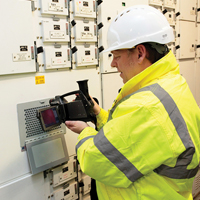 ‘Live’ Thermal Inspection Saves Costs And Assures Reliability
‘Live’ Thermal Inspection Saves Costs And Assures Reliability
An infrared window is a data collection point for a thermal imaging camera and adoption of this technology is growing fast as increased awareness of electrical safety and risk reduction drives its acceptance.
Critically, IR windows also enable systems to be inspected under load so their true ‘health status’ can be quickly ascertained.
Suitable for every industry that utilises energy, (Read More)
IR windows save inspection time whilst facilitating more efficient and safer workplace practices. They eliminate the need for cumbersome personal protective equipment by negating the need to remove panel covers.
Advertisement - Hover to see more
The result is a streamlined process which cuts up to 90% of man hours spent on traditional inspections whilst increasing the quality of inspections and safety of personnel.
Various types of lens materials can be used in IR windows but one that is proving increasingly popular is industrial grade, transmissive polymer. It is immune from the mechanical stresses that can cause a fluoride crystal lens to shatter.
As the following Stansted Airport application explains, the material can also be economically used to create an IR window of any shape or size to suit the application, allowing multiple components and busbars to be inspected in a single camera scan.
London Stansted Airport, February 2013 – With the installation of IRISS CAP Series polymer infrared windows, savings on thermographic inspection time and associated costs have been massive. Payback was instant but benefit extends way beyond that. If the airport fails to meet an agreed level of service, compensation becomes due to its customers, the airlines and handling agents. This new method of inspection also provides a critical safeguard against this likelihood.
As the airport is open for business 24/7, engineers only had four hours per night in which to conduct predictive maintenance of low voltage equipment. By the time they made the system safe, the window of opportunity reduced even more. This meant the entire inspection cycle was significantly protracted and no system could be checked under load.
Although efficient maintenance had so far prevented serious low voltage system failures, Engineering Compliance Manager, David Potter, wanted greater assurance. He had considered infrared windows to complement outsourced thermal imaging surveys but crystal versions were both impractical and unsuitable given the size of the equipment that needed to be monitored.
The ‘Eureka’ moment came when David Potter read about IRISS’ Custom Application Product (CAP) Series infrared windows made from transmissive polymer. This fully impact resistant material allows the window to be any size which is perfect for applications involving large switchgear.
David Potter continued: “It’s rare to see something completely new that works well. The specification was approved on 6th November 2012, a comprehensive installation plan was then drawn up by IRISS and the entire job was completed by Christmas.”
IRISS worked flexibly to complete the job within the time constraints imposed by the 24-hour operation. In total 72 windows were installed, comprising a combination of 6”, 12” and 24” products all available in the standard range. The largest window is of course ideal for the thermal inspection of busbars and multiple components.
Following the installation of the IRISS CAP Series windows, the impact on inspection time was immediate. IRISS undertook the first thermal imaging survey with the benefit of its infrared windows in January this year.
It took just five hours to complete the job in daylight hours. Previously it would take engineers two nights to inspect just one panel. There was no need for isolations or back feed and personnel safety is completely assured. A single thermographer without full PPE can do everything.
“I now have a print out of each system’s thermal performance and, for the first time, a benchmark on which to base future thermal inspections,” David Potter continued. “Previously, it would have taken us a couple of years to inspect the complete network and even then we had no idea of what was happening under load.”
He concluded: “Now we can see the live circuits and cables and the temperature rise on busbars. This means we are able to apply trends to every system. I now know the airport terminal is truly safe and that’s a big tick against my list. I’m really sold on this technology.”
IRISS, Ltd. Unit 2,
Grafton Place, Montrose Road, Chelmsford, Essex, CM2 6TG, United Kingdom
Tel: +44 (0) 1245 399 713
Fax: +44 (0) 1245 462 396
Email: This email address is being protected from spambots. You need JavaScript enabled to view it.
Website: www.iriss.com

